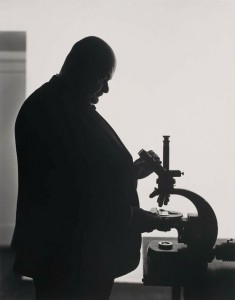
This post started several hours ago.
I had seen a note in the Boston Globe on an exhibit of photographs by Yousuf Karsh (‘Karsh of Ottawa’) (1908-2002) at the Armenian Library and Museum of America in Watertown, Mass. I wanted to tout the exhibit.
But not without reason has a good friend dubbed me ‘the great digressor’, as this post will confirm. Now back to my morning….
Scroll through the dozens of Karsh photos on the internet, and you’ll find tens to which ‘iconic’ correctly applies. They forever define their subjects: most famously Churchill, Einstein and Hemingway. I love this one of George Bernard Shaw and this one of Alberto Giacometti.
But for some time I couldn’t find on line my favorite Karsh image, a portrait of the photographer and biologist, Roman Vishniac (1897-1990).
Until I saw it a couple of years ago in Boston’s Museum of Fine Arts, I only knew Roman Vishniac through his justly famous A Vanished World (1983). It is – and was intended to be – a haunting array of images of Jewish life in Poland in the late 1930s.
I had no idea this gifted portraitist was also a scientist of note, as the MFA’s descriptive card said. His field was ‘photomicroscopy, the photography of specimens as seen through a microscope’. The portrait affected me because it seemed to reflect a man so haunted by the ‘vanished world’ he’d recorded that he’d turned away from humans as wholes and to their cells.
This morning, as I looked for the portrait, I found a New York Times Magazine article from April 2010, ‘A Closer Reading of Roman Vishniac’ by Tablet editor-in-chief, Alana Newhouse.
Newhouse reports the research of Maya Benton, a curator at New York’s International Center of Photography. Newhouse’s story (which is exceptionally well told) and Karsh’s portrait reminded me what unreliable narrators photographers are. For outside of his science, Vishniac was a fabulist.
His tale of how his photographs from the Pale of Settlement came to be taken omitted that they were commissioned by a Jewish relief organization. When first published in the 1930s, his images were intended to generate contributions. Hence, the emphasis on the isolated, poor, oppressed and Orthodox. After the war, Vishniac selected, cropped, captioned and organized his images to reinforce that picture of Jewish life.
The reality, Benton has learnt from her study of Vishniac’s archives, was very different. Ironically, she believes, Vishniac’s editing of his own work in service to his fiction dimmed, rather than enhanced, his deserved eminence as a photographer. And beyond question, it is deserved.
So, it seems to me, Karsh got Vishniac as his subject intended. He captured the image not the man.
(I can’t omit mention of Vishniac’s daughter, Mara. According to Newhouse, from childhood she and her father had a difficult relationship. Because of her brother’s untimely death, she became her father’s curator. It was she who opened her father’s records to Benton and she who has seen to their preservation at the International Center of Photography. She is a hero.)
Because I was so struck by Newhouse’s writing, I looked at Tablet which bills itself as ‘A New Read on Jewish Life’. In my youth, billboards reminded that ‘You don’t have to be Jewish to love Levy’s Jewish rye bread’. So, too, Tablet to which I’ve subscribed.
That was my morning. And a good one, it was.
Recent Comments